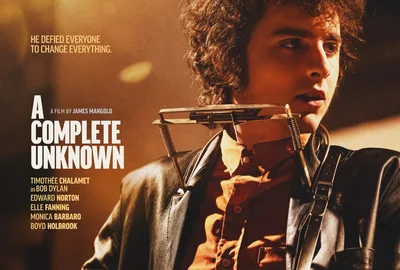Bob Dylan
-
A Complete Unknown
published: 1 /
2 /
2025

Lisa Torem enjoys new Bob Dylan biopic, ‘A Complete Unknown,’ but still has burning questions about the Nobel Prize Winner’s legacy.
Article
The James Mangold directed Bob Dylan biopic, ‘A Complete Unknown,’ in which Timothee Chalamet portrays one of America’s most lauded folk poets, is as satisfying and bountiful as a holiday Bouillabaisse. The film will, undoubtedly, be nominated for Best Picture of the Year in 2025, as the acting is period perfect and the thriving Greenwich Village scene (Café Wha, Gerte’s Folk Club, etc.) was impeccably researched, but the real beauty is that the film cracks opens the door to the Nobel Prize Winner’s legacy, while applauding the colourful characters that inspired him.
The Woody Guthrie character (writer of ‘This Land is Your Land,’ etc.) features prominently in an early scene. The grungy Dylan character, who cluelessly stiffs a cab driver, visits the hospital room where Guthrie and friend/fellow folkie Pete Seeger (‘Where Have All the Flowers Gone’, etc.), hold court. Guthrie, at this period-of-time stricken with Huntington’s disease, has difficulty communicating verbally, but the gleam in his eyes illustrates that he’s excited about the troubadour’s random appearance, especially when Dylan says that he’s written a song for Guthrie, which both men are anxious to hear him perform. It is this scene which projects the relationship between ‘Seeger’ and ‘Dylan’ positively forward.
We also see Seeger’s character, portrayed by Ed Norton, in a court hearing during the dark McCarthy period, when various American artists were accused of communist leanings, and were frequently blacklisted.
Ultimately, Seeger’ is stuck between a rock and a hard place when presiding over the Newport Folk Concert--he is besieged by demands from the administration to control Dylan’s activities, while Dylan ramps up accolades from legend Johnny Cash for unveiling a new sound.
Screen time is given to singer/’60s activist Joan Baez (portrayed by Monica Barbaro), with whom Dylan shared a brief romantic, and often contentious relationship. That said, their affair came off as conveniently symbiotic. Although they met when Baez was already famous, she, in my opinion, upped her game by performing with Dylan live, and by promoting his meaningful songs with her illustrious soprano.
At one uncomfortable junction, however, Dylan patronizes Baez by comparing her “poetry” to an oil painting at a dentist’s office. It wasn’t until she penned, ‘Diamond and Rust,’ a ballad that cryptically described their affair, that, by many accounts, she proved herself as a bona fide songwriter.
Dylan’s early love from 1961-1964, Suze Rotolo, portrayed by Elle Fanning, and here known as ‘Sylvie’, is also given fair shrift. She comes across, to me, as completely supportive of Dylan’s lyrical nuance and intrepid, rough-house, guitar playing. She provided the unconditional support that Dylan sorely needed in the early stages of his career. The gratuitous scenes, in which she shows vulnerability caused by her lover’s unwieldy fame, and other romantic attractions, were touching and telling.
Of course, all roads point to Elijah Wald’s ‘Dylan Goes Electric’ (2015), the book which provides a tidy time scape for the screenplay. Tensions rise at the film’s controversial high point, the famed 1965 Newport Folk Festival performance, in which Dylan insisted on plugging in, with the likes of Chicago’s Mike Bloomfield and Al Cooper, among others.
The film serves as an honourable entryway into Dylan’s gripping catalogue. After the holiday viewing, I was anxious to hear more of his early works, and I relished the opportunity to pore through his deep, often dark, sensual phrasings at leisure.
On the other hand, I do have one gripe. Recently, I discovered an online press conference, in which the real Bob Dylan had the arduous task of responding to a series of innocuous questions from a room full of loudmouth (primarily male) reporters. While, in the film, the screen character often appeared abrasive and non-communicative relative to similar queries, here, he came off as boyish, self-aware, and charming. It was here, not in the film, that I understood the palpable attraction he held for fans and paramours.
Here, a prolific artist who wrote genius songs, was under the gun to codify his craft in front of a group of strangers. By my account, few questions had been well-researched. While some may have viewed Dylan’s frank answers as curt, I saw his responses as tactfully succinct. How many of us can comprehend the magical pull of “the muse,” not least, the artists that lay bare their soul to them? What did they expect him to pull out of his hat?
In any event, ‘A Complete Unknown’ led me to re-discover Bob Dylan, his massive body of work, the talented shoulders on which he has stood, and on which so many subsequent artists derived inspiration, not least John Lennon.
Finally, do we now know the real Bob Dylan? Are we capable of understanding his muse, or anybody’s muse? Or is deriving pleasure and cultural awareness from his catalogue enough for the time being? See the film and let us know.
Band Links:-
http://bobdylan.com/
https://www.facebook.com/bobdylan
https://twitter.com/bobdylan
https://www.youtube.com/user/BobDylanV
http://www.songkick.com/artists/408511
Play in YouTube:-